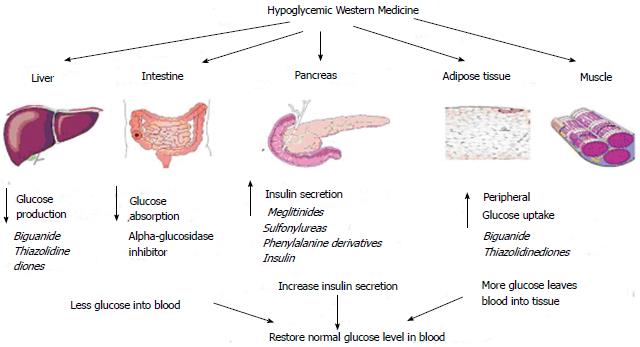Copyright
©2014 Baishideng Publishing Group Co.
World J Diabetes. Apr 15, 2014; 5(2): 176-197
Published online Apr 15, 2014. doi: 10.4239/wjd.v5.i2.176
Published online Apr 15, 2014. doi: 10.4239/wjd.v5.i2.176
Figure 1 Pathophysiological mechanisms of hyperglycemia matched with the suitable pharmacotherapeutics (Data adapted from Hui et al[3]).
Figure 2 Insulin signaling pathway and insulin insensitive.
The inner part of insulin receptor (IR) reveals a tyrosine kinase activity and coupled with multifunctional docking proteins IRS-1 and IRS-2. The in turn signaling leads to an activation of the MAPK cascade involved in mitogenesis and the open status of a hexose transporter protein (GLUTs) which is located in the cell membrane and is the only channel for glucose entery into cells. The decreased serine/threonine phosphorylation of IR, inactivates hexokinase and glycogen synthase, as well as defects in the phosphorylation of glucose transporter protein (GLUT4) and genetic primary defect in mitochondrial fatty acid oxidation, leading to insulin resistance and an increase of triglyceride synthesis contribute to this insulin insensitivity. The action sites of hypoglycemia herbs are indicated with red arrows[3].
Figure 3 Effects of adiponectin on carbohydrate and lipid metabolism in liver and skeletal muscle (c.
f. http://www.jpp.krakow.pl/.../articles/08_article.html[119]). FAT: Fatty acid translocase.
Figure 4 Effects of active glucagon-like peptide-1 and dipeptidylpeptidase-4 on glucose homeostasis [(c.
f. http://www.medscape.com) Am J Health Syst Pharm, 2007]. GLP-1: Glucagon-like peptide-1; DPP-4: Dipeptidylpeptidase-4.
- Citation: El-Abhar HS, Schaalan MF. Phytotherapy in diabetes: Review on potential mechanistic perspectives. World J Diabetes 2014; 5(2): 176-197
- URL: https://www.wjgnet.com/1948-9358/full/v5/i2/176.htm
- DOI: https://dx.doi.org/10.4239/wjd.v5.i2.176












